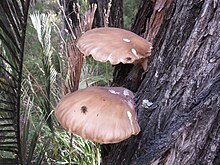Pleurotus australis
| Pleurotus australis | |
|---|---|
 | |
| Pleurotus australis (brown oyster mushroom) on peppermint tree, Callcup block, D'Entrecasteaux National Park, April 2017 | |
| Scientific classification | |
| Domain: | Eukaryota |
| Kingdom: | Fungi |
| Division: | Basidiomycota |
| Class: | Agaricomycetes |
| Order: | Agaricales |
| Family: | Pleurotaceae |
| Genus: | Pleurotus |
| Species: | P. australis |
| Binomial name | |
| Pleurotus australis | |
| Synonyms | |
| Pleurotus australis | |
|---|---|
| Gills on hymenium | |
| Cap is offset | |
| Hymenium is decurrent | |
| Lacks a stipe | |
| Ecology is saprotrophic | |
| Edibility is unknown | |
Pleurotus australis, the brown oyster mushroom, is a gilled fungus native to Australia and New Zealand. [2] It is found on dead wood, particularly mānuka and ngāhere.[2] Although morphologically similar to some other Pleurotus fungi, it has been shown to be a distinct species incapable of cross-breeding.[3][4]
See also
[edit]References
[edit]- ^ "Pleurotus australis". Interactive Catalogue of Australian Fungi. Royal Botanic Gardens Melbourne. Archived from the original on 2011-03-15. Retrieved 2011-03-10.
- ^ a b Sisson, Liv; Vigus, Paula (2023). Fungi of Aotearoa: a curious forager's field guide. Auckland, New Zealand: Penguin Books. p. 110. ISBN 978-1-76104-787-9. OCLC 1372569849.
- ^ Zervakis, Georgios I.; Moncalvo, Jean-Marc; Vilgalys, Rytas (2004). "Molecular phylogeny, biogeography and speciation of the mushroom species Pleurotus cystidiosus and allied taxa". Microbiology. 150 (Pt 3): 715–726. doi:10.1099/mic.0.26673-0. PMID 14993321.
- ^ Segedin, BP; Buchanan, PK; Wilkie, JP (1995). "Studies in the Agaricales of New Zealand: New species, new records and renamed species of Pleurotus (Pleurotaceae)". Australian Systematic Botany. 8 (3): 453–482. doi:10.1071/SB9950453.
External links
[edit]- Biological Species in Pleurotus: ISG XIV. Pleurotus australis at University of Tennessee-Knoxville Mycology Lab
- "Pleurotus australis (Cooke & Massee) Sacc". Atlas of Living Australia.


 French
French Deutsch
Deutsch